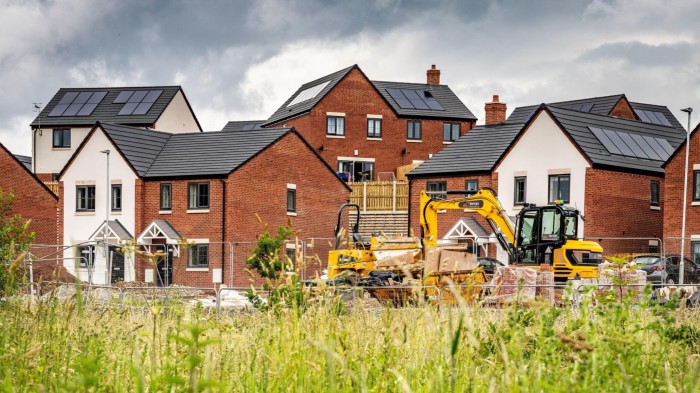Measures to boost housebuilding in England risk being thwarted

Unlock the Editor’s Digest for free
Roula Khalaf, Editor of the FT, selects her favourite stories in this weekly newsletter.
Measures designed to smooth the UK government’s new planning rules by giving local councils time to adapt to higher housing targets risk delaying their impact for years, experts have warned.
A “landmark overhaul” of England’s planning regime to be published on Thursday will increase the pressure on councils to use “local plans” for development that set out where homes should be built, in order to speed up future decision-making.
But plans that reflect the new targets could take years to put in place, even as Labour races to turn around a decline in housebuilding and increase building across the country to the highest level in decades.
“The plan-led system that Labour is still clearly fully behind still [has] a lot of lag built in,” said Ben Simpson, planning director at consultancy Lichfields. “They could have gone further.”
Transition arrangements mean higher housing targets will not apply right away for local councils that already have a plan in place based on existing lower housing targets, or are close to finalising one.
Graham Prothero, chief executive of housebuilder MJ Gleeson, praised the government’s quick action on planning, but said these reforms “will start to benefit the [housing] numbers in three, four, five, six, seven years”.
The new policy, to be outlined by deputy prime minister Angela Rayner, brings tougher housing targets for local authorities that total 370,000 new homes every year, and requires councils to build on so-called grey belt sites within the greenbelt to meet those goals.
But experts worry the transition to the new policy will create opportunities for anti-development authorities to delay adopting the new targets for years.
The British Property Federation industry, in its submission to the official planning consultation, urged the government to accelerate the transition or risk “undermining their wider aspiration to get to 1.5mn homes over the course of this parliament as certain plans across the country simply will not be ambitious enough on housing numbers”.
The National Housing Federation, which represents affordable housing providers, and the Home Builders Federation industry group have warned that overall the government is on track to miss the 1.5mn target by almost one-third.
The number of new homes in England fell 6 per cent to 221,070 in the year to March.
Lichfields calculated the original transition rules could cost some 70,000 homes over the five years.
The final policy published Thursday would include some tweaks aimed at speeding up the transition, the Ministry of Housing, Communities and Local Government said.
These include requiring councils to commit to a timetable for a new local plan within three months, and forcing those with the old targets in their local plans to face higher requirements in mid-2026.
However, where an existing local plan is close to the government’s new ambition — by a certain percentage — the council will not have to go back to the drawing board.
“They have put in a couple of provisions that are going to put pressure on local authorities to crack on,” said Simpson at Lichfields. “In the scale of the overall need, I don’t think it is going to make a huge difference.”
He warned that the delays to plan-making would result in more developers taking councils to the planning appeals process, since appeals would immediately be judged against the new policy and were therefore more likely to be successful.
The government’s plan to rewrite the national planning framework has already prompted a backlash from community groups that have warned that “sky-high” targets for new buildings will damage green spaces.
Campaigners are particularly concerned about plans to reclassify low-quality land, such as old car parks or scrubland within the greenbelt, as “grey belt”. This would make it easier to build new schemes.
Lichfields estimate that up to 500,000 homes could be built on grey belt land over five years, requiring less than 1 per cent of the current greenbelt.
The government says any new developments on the grey belt will have to meet “golden rules” including requirements to provide infrastructure such as nurseries, GP surgeries, transport and affordable housing.
But Rosie Pearson, co-founder of the Community Planning Alliance, said most voters wanted the government to protect nature and green spaces. “This is a litmus test for the new Labour government, which despite being hell-bent on hitting its sky-high, developer-led housing targets, must not sacrifice the environment.”
#Measures #boost #housebuilding #England #risk #thwarted






